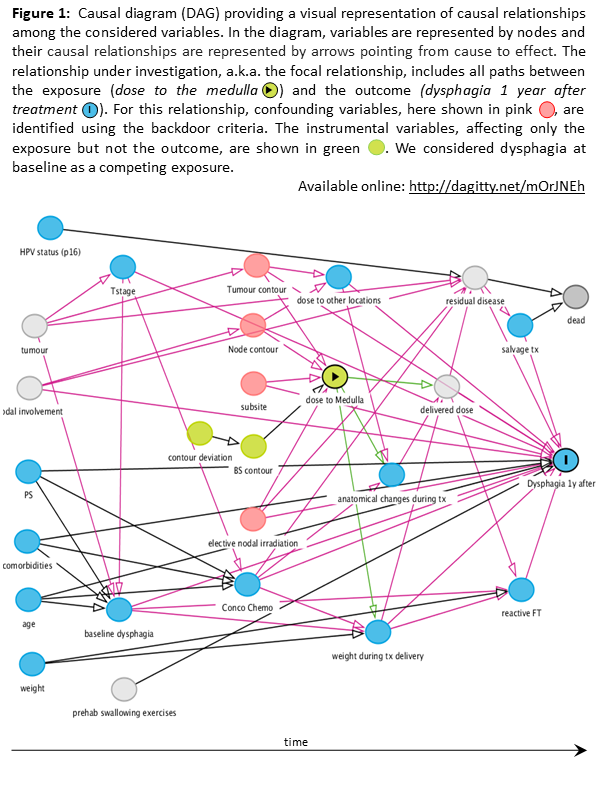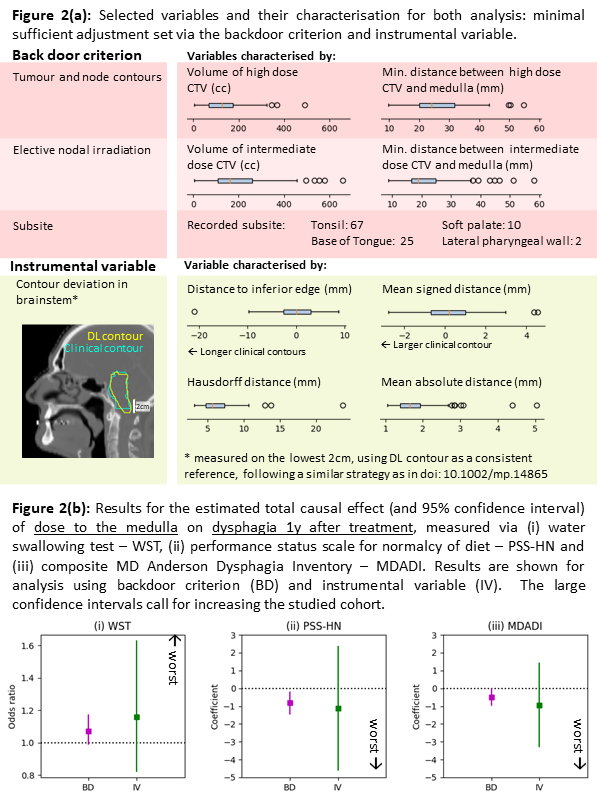Dose-effect relationship for the medulla and dysphagia studied with causal inference methods
OC-0450
Abstract
Dose-effect relationship for the medulla and dysphagia studied with causal inference methods
Authors: Eliana Maria Vasquez Osorio1, Deborah Ganderton2, Azadeh Abravan1, Gareth Price1, James Price3, Lip Wai Lee3, Alan McWilliam1, Matthew Sperrin4, Marcel van Herk1
1The University of Manchester, Division of Cancer Sciences, Manchester, United Kingdom; 2The Christie NHS Foundation Trust, Dept Speech and Language Therapy, Manchester, United Kingdom; 3The Christie NHS Foundation Trust, Dept of Clinical Oncology, Manchester, United Kingdom; 4The University of Manchester, Division of Informatics, Imaging & Data Sciences, Manchester, United Kingdom
Show Affiliations
Hide Affiliations
Purpose or Objective
Using voxel-wise analysis, a strong association was recently found between dose to the medulla (located inferiorly in the brainstem) and dysphagia 1 year after head and neck (HN) radiotherapy (RT). However, association does not imply causation. In this work, we applied causal inference methods to estimate the total causal effect of dose to the medulla and dysphagia 1 year after RT.
Material and Methods
We analysed 104 sequential HN cancer patients treated with definitive (chemo)RT. Dysphagia was assessed pre-treatment and at 1 year after RT using validated measures: 1) composite M.D. Anderson Dysphagia Inventory (MDADI), 2) performance status scale for normalcy of diet (PSS-HN), 3) water swallow test (WST). Besides demographics and treatment characteristics, we collected the mean dose to the medulla, in equivalent dose in 2Gy/fraction with α/β=3Gy, for every patient.
For causal inference, the first step is to construct a causal diagram representing the understanding (and assumptions) of the major causal influences among variables affecting the investigated relationship [Pearl 1995]. We generated such a diagram, Fig. 1, in extensive multi-disciplinary discussions including 2 clinical oncologists, a speech & language therapist, a statistician, 4 physicists and a computer scientist. Based on the diagram, 4 confounders affecting both the exposure (dose to the medulla) and the outcome (dysphagia 1 year after treatment) were identified using the backdoor criterion. We also identified one possible instrumental variable, affecting the exposure but not the outcome. We characterised these variables, Fig. 2(a), and estimated the total causal effect of the mean dose to the medulla on each dysphagia measure using two types of analysis: conditioning on confounders (backdoor analysis, BD) and using two-stage least squares (for instrumental variables, IV), considering dysphagia pre-treatment as a competing exposure.

Results
Figure 2(b) presents the estimated total causal effect of mean dose to the medulla for each dysphagia measure. BD and IV estimates were similar. However, IV confidence intervals were much larger, suggesting the instrumental variable is weak. Looking at BD estimates, odd ratios suggest that the chance of failing WST 1 year after RT increase by 7% per Gy given to the medulla. Similarly, from the coefficients of the linear regressions, PSS-HN decreases by 0.8 points per Gy and MDADI decreased by 0.5 points per Gy.

Conclusion
We present evidence of causality between mean dose to the medulla and dysphagia 1 year after head and neck RT. To our knowledge, this is the first time that causal inference with an expert consensus causal diagram is used to find RT dose-effect relationships. Adoption of causal analysis in outcome modelling will help overcome current limitations in methodologies, as we can investigate causation rather than associations. Our analysis paves the way for clinical trials of medulla sparing to ultimately develop interventions to improve quality of life of cancer survivors.